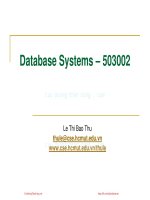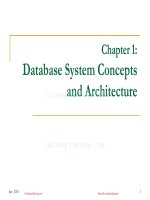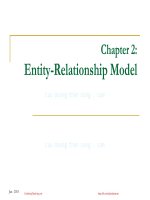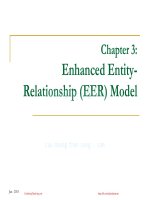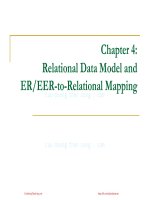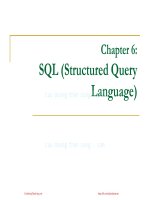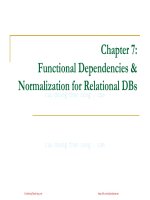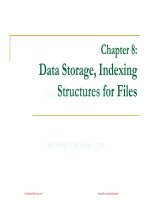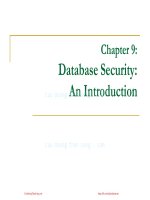cơ sở dữ liệu lê thị bảo thu chương ter 05 relational algebra sinhvienzone com
Bạn đang xem bản rút gọn của tài liệu. Xem và tải ngay bản đầy đủ của tài liệu tại đây (2.02 MB, 82 trang )
Chapter 5:
Relational Algebra
CuuDuongThanCong.com
/>
Contents
1
Unary Relational Operations
2
Relational Algebra Operations from Set Theory
3
Binary Relational Operations
4
Additional Relational Operations
5
Brief Introduction to Relational Calculus
Jan - 2015
CuuDuongThanCong.com
/>
2
Contents
1
Unary Relational Operations
2
Relational Algebra Operations from Set Theory
3
Binary Relational Operations
4
Additional Relational Operations
5
Brief Introduction to Relational Calculus
Jan - 2015
CuuDuongThanCong.com
/>
3
Relational Algebra Overview
Relational algebra is the basic set of operations
for the relational model.
The result of an operation is a new relation,
which may have been formed from one or more
input relations.
These operations enable a user to specify basic
retrieval requests (or queries).
This property makes the algebra “closed” (all objects
in relational algebra are relations).
A sequence of relational algebra operations
forms a relational algebra expression.
Jan - 2015
CuuDuongThanCong.com
/>
4
Relational Algebra Overview
Unary Relational Operations:
Relational Algebra Operations from Set Theory:
UNION (), INTERSECTION (), DIFFERENCE (or
MINUS, –)
CARTESIAN PRODUCT ( x )
Binary Relational Operations:
SELECT (symbol: (sigma))
PROJECT (symbol: (pi))
RENAME (symbol: (rho))
JOIN (several variations of JOIN exist)
DIVISION
Additional Relational Operations:
Jan - 2015
OUTER JOINS, OUTER UNION
AGGREGATE FUNCTIONS (SUM, COUNT, AVG, MIN,
MAX)
CuuDuongThanCong.com
/>
5
COMPANY Database Schema
CuuDuongThanCong.com
/>
6
The following query results refer to this database state
Jan - 2015
CuuDuongThanCong.com
/>
7
The following query results refer to this database state
CuuDuongThanCong.com
/>
8
Unary Relational Operations: SELECT
The SELECT operation (denoted by
(sigma)) is used to select a subset of the
tuples from a relation based on a selection
condition.
Examples:
Select the EMPLOYEE tuples whose department
number is 4:
DNO = 4 (EMPLOYEE)
Select the employee tuples whose salary is greater
than $30,000:
SALARY > 30,000 (EMPLOYEE)
Jan - 2015
CuuDuongThanCong.com
/>
9
Unary Relational Operations: SELECT
In general, the select operation is denoted by
<selection condition>(R) where
(sigma) is used to denote the select operator.
Jan - 2015
<selection condition> is a Boolean expression
specified on the attributes of relation R.
Tuples that make the condition true appear in the
result of the operation, and tuples that make the
condition false are discarded from the result of
the operation.
CuuDuongThanCong.com
/>
10
Unary Relational Operations: SELECT
SELECT Operation Properties
The relation S = <selection condition>(R) has the same schema
(same attributes) as R.
SELECT is commutative:
<cond1>( < cond2>(R)) = <cond2>(<cond1>(R))
Because of commutativity property, a cascade (sequence)
of SELECT operations may be applied in any order:
<cond1>(<cond2>(<cond3>(R))
= <cond2>(<cond3>(<cond1>(R)))
= <cond1>AND<cond2>AND<cond3>(R)
Jan - 2015
The number of tuples in the result of a SELECT is less
than (or equal to) the number of tuples in the input relation
R.
CuuDuongThanCong.com
/>
11
Example of SELECT operation
Jan - 2015
CuuDuongThanCong.com
/>
12
Unary Relational Operations: PROJECT
PROJECT Operation is denoted by (pi).
This operation keeps certain columns
(attributes) from a relation and discards the
other columns.
PROJECT creates a vertical partitioning: the list of
specified columns (attributes) is kept in each
tuple, the other attributes in each tuple are
discarded.
Example: To list each employee‘s first and
last name and salary, the following is used:
LNAME, FNAME,SALARY(EMPLOYEE)
Jan - 2015
CuuDuongThanCong.com
/>
13
Unary Relational Operations: PROJECT
The general form of the project operation is:
<attribute list>(R)
<attribute list> is the desired list of attributes from
relation R
The project operation removes any
duplicate tuples because the result of the
project operation do not allow duplicate
elements.
Jan - 2015
CuuDuongThanCong.com
/>
14
Unary Relational Operations: PROJECT
PROJECT Operation Properties
The number of tuples in the result of projection
<list>(R) is always less than or equal to the
number of tuples in R.
If the list of attributes includes a key of R, then the
number of tuples in the result of PROJECT is equal to
the number of tuples in R.
PROJECT is not commutative
<list1> ( <list2> (R) ) = <list1> (R) as long as <list2>
contains the attributes in <list1>
Jan - 2015
CuuDuongThanCong.com
/>
15
Example of PROJECT operation
Jan - 2015
CuuDuongThanCong.com
/>
16
Examples of applying SELECT and
PROJECT operations
Jan - 2015
CuuDuongThanCong.com
/>
17
Relational Algebra Expressions
We may want to apply several relational
algebra operations one after the other.
Either we can write the operations as a single
relational algebra expression by nesting the
operations, or
We can apply one operation at a time and create
intermediate result relations.
In the latter case, we must give names to the
relations that hold the intermediate results.
Jan - 2015
CuuDuongThanCong.com
/>
18
Single expression versus sequence of
relational operations
To retrieve the first name, last name, and salary of all
employees who work in department number 5, we must
apply a select and a project operation.
We can write a single relational algebra expression as
follows:
FNAME, LNAME, SALARY( DNO=5(EMPLOYEE))
OR We can explicitly show the sequence of operations,
giving a name to each intermediate relation:
Jan - 2015
DEP5_EMPS DNO=5(EMPLOYEE)
RESULT FNAME, LNAME, SALARY (DEP5_EMPS)
CuuDuongThanCong.com
/>
19
Unary Relational Operations:
RENAME
The RENAME operator is denoted by (rho).
In some cases, we may want to rename the
attributes of a relation or the relation name or
both.
Jan - 2015
Useful when a query requires multiple operations.
Necessary in some cases (see JOIN operation
later).
CuuDuongThanCong.com
/>
20
Unary Relational Operations:
RENAME
The general RENAME operation can be
expressed by any of the following forms:
S (B1, B2, …, Bn )(R) changes both:
S(R) changes:
the relation name only to S
(B1, B2, …, Bn )(R) changes:
Jan - 2015
the relation name to S, and
the column (attribute) names to B1, B1, …..Bn
the column (attribute) names only to B1, B1, …..Bn
CuuDuongThanCong.com
/>
21
Contents
1
Unary Relational Operations
2
Relational Algebra Operations from Set Theory
3
Binary Relational Operations
4
Additional Relational Operations
5
Brief Introduction to Relational Calculus
Jan - 2015
CuuDuongThanCong.com
/>
22
Relational Algebra Operations from
Set Theory: UNION
Binary operation, denoted by .
The result of R S, is a relation that includes all
tuples that are either in R or in S or in both R
and S.
Duplicate tuples are eliminated.
The two operand relations R and S must be
“type compatible” (or UNION compatible):
Jan - 2015
R and S must have same number of attributes.
Each pair of corresponding attributes must be type
compatible (have same or compatible domains).
CuuDuongThanCong.com
/>
23
Example of the result of a UNION
operation
Jan - 2015
CuuDuongThanCong.com
/>
24
Relational Algebra Operations from
Set Theory
Type Compatibility of operands is required for
the binary set operation UNION , (also for
INTERSECTION , SET DIFFERENCE –).
The resulting relation for R1R2 (also for
R1R2, or R1–R2) has the same attribute
names as the first operand relation R1 (by
convention).
Jan - 2015
CuuDuongThanCong.com
/>
25
